As gear enthusiasts, it’s natural to focus on the end products themselves. But have you ever wondered, “Who designed this and what inspired them?” Digging into the creative process and the minds behind products is a fascinating journey, but often one that is overlooked. That’s why we’re shining a well-deserved spotlight on the unsung heroes of the design industry.
These designers help bring amazing concepts to life across a diverse range of categories, from footwear to bags, outdoor gear, and sporting equipment. And since design is a visual medium, Instagram is the ideal place to follow them and keep up to date with their creative pursuits…
Patrick Christian
Patrick Christian is a freelance industrial designer based in the San Francisco Bay Area. A deep love of skateboarding, art, and music has allowed him to bring a unique design twist to everyday objects. His wide-ranging design experience ranges from bags and tech cases to workout equipment and beyond, with a keen interest in encouraging both physical and mental health values. Delve deeper into his work and inspirations on Instagram, Pinterest, and his personal website.
How did you get into design?
As a kid I was into skateboarding, art, film, and music, that’s what ultimately contributed to and transformed into my interest in design. I’ve always needed some type of creative outlet to stay mentally balanced, so it only made sense that my career reflected that need. During my time in college I discovered industrial design when I decided to change my major from mechanical engineering. This was an inflection point in my life where I found a productive source of deeper creative purpose.
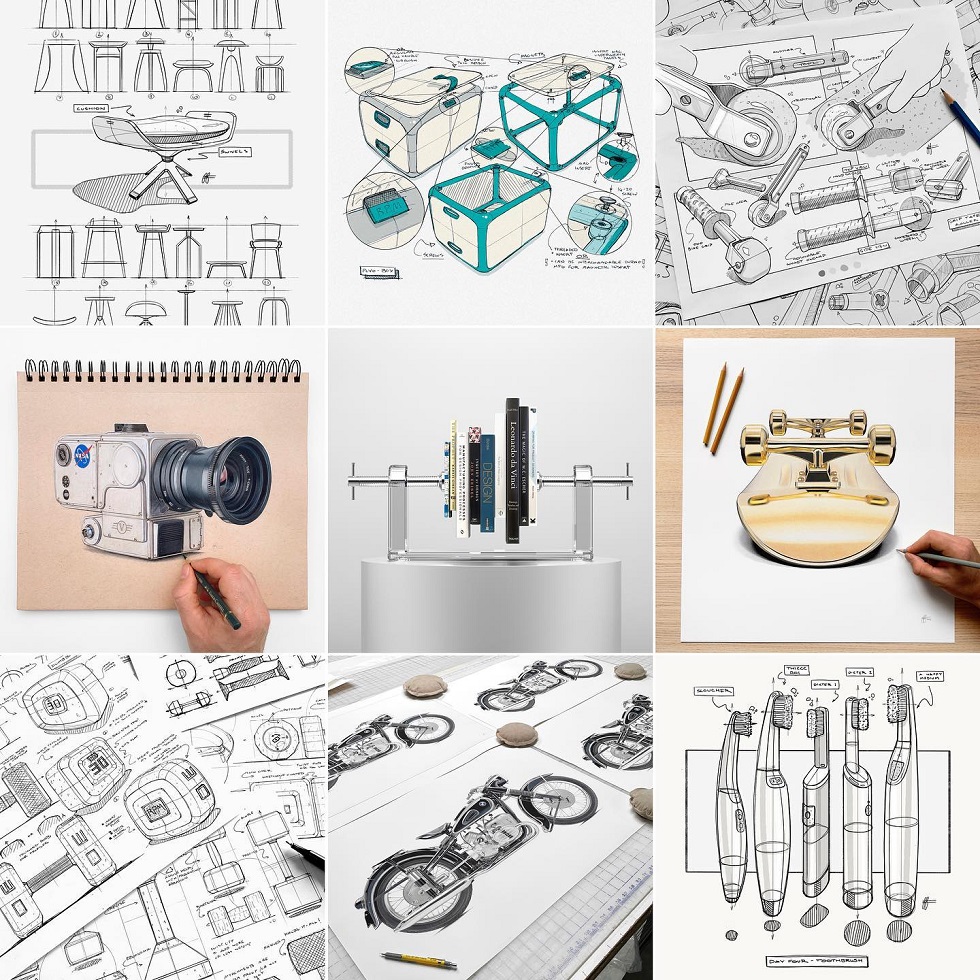
What inspires your work?
Everything in life does, but some notable sources are people, mental health, nature, adversity, imperfection, and humor. Truthfully, skateboarding has been a big inspiration to me as an industrial designer. I realized that industrial design could take the creative outlook I love about skating, and apply that way of thinking in a way that I could use to influence the physical world around me. Being a skater has also really helped me with having a unique viewpoint in my career; skaters see the world through a different lens. We see spots and creative opportunities where other people just see a piece of concrete, stairset, or handrail, and we use those super normal everyday objects to reimagine how we interact with the world and express it through the art form of skating. This type of thinking can really be leveraged and used to my advantage when it comes to creative ideas in industrial design, allowing me to find opportunities, multiple affordances, and inspiration where others wouldn’t typically look.
What products do you specialize in?
I strive to create products that question the norm and improve the human experience. Some products I’ve designed that have gone to market include workout equipment, backpacks, and phone cases. One of the things I enjoy about my career is my versatility; I don’t have to stick to designing one thing since my skill set and human-centered design process can apply across product categories. I’m constantly questioning the expected while I’m designing, and focusing on creating products and experiences that embed healthy values back into people’s lives through meaningful design. My goal is to stay true to these intentions through designing products that improve people’s physical and mental health, and are ideally more sustainable.
What have you worked on that you’re proud of and can share with our community?
I spearheaded the design of the entire family of home workout equipment for RPM Training’s Atom kit, which is a functional home gym and workout program. Each product was its own unique design challenge culminating together to create the story of the complete family of fitness products. I’m specifically proud of the dumbbell and kettlebell designs, both of which I use to work out with daily. All of these products were designed to last the test of time and have functional and aesthetic improvements from what’s currently out on the market. I love that these products are items people will own for a long time and that these designs are helping people become physically healthier.
Suzanne Oude Hengel
Suzanne Oude Hengel uses her creative expertise to bridge the gap between footwear and knitting technologies. She takes a multi-level approach to knit development spanning design, engineering, and product development. Based in the Netherlands, she has worked with brands such as Rothy’s and Timberland as a freelance footwear and knit designer and is the founder of Knit in Motion. Discover more on her personal website and delve into her design journey on Instagram.
How did you get into design?
I have always been creative but I really got into design whilst studying Product Design at ArtEZ University. It was whilst at university I found my love for footwear and knitting.
What inspires your work?
I take inspiration from a lot of different places such as things I see around me, architecture, etc. However, my main inspiration are the challenges found in the engineering of knitted fabrics themselves. Problem-solving means learning or trying something differently, and for me this is a lot of fun.
What products do you specialize in?
I specialize in footwear but love all functional products.
What have you worked on that you’re proud of and can share with our community?
I am really proud of my recent collaboration with Timberland, alongside 5 other amazing creatives. Within my product I was able to push the boundaries of knitting and what is expected from the Timberland 6inch boot. I can’t share too many details yet but stay tuned!
Also, it’s not so much a product but I am really proud of launching my new company Knit in Motion together with my amazing team. Knit in Motion is a knit development and consultancy studio specializing in custom-engineered knitted fabrics. It’s been a long process but full of learnings and self-growth!
Brent Radewald
From designing bags to soccer balls, Brent Radewald isn’t afraid to step outside his comfort zone and embrace diverse design challenges. Based in Portland, Oregon, he is a product designer for Nike, working across a range of soft goods categories. Learn more about his projects on his personal website and follow his adventures into design and the great outdoors via Instagram.
How did you get into design?
I was a very artistic kid who also loved the organized structure of math/science. My original plan was to be an architect or engineer until I saw the documentary “Objectified”. I had no idea industrial design was an option before that. It felt like the perfect job for a kid like me, so I attended the University of Cincinnati for industrial design and immediately fell in love with the field.
What inspires your work?
Nature has always been my favorite place to find inspiration. But really what drives me as a designer is the need to solve complex problems. It’s satisfying to find the right solution to a problem with tons of variables. That’s probably why I’m so obsessed with games like chess!
What products do you specialize in?
My specialty is soft goods design. Specifically bags, headwear, and socks. But bags will always be my main passion. I’ve also dipped into the specialized field of soccer ball design for the past 5 years. It’s a product type I never expected to touch in my career, but I quickly fell in love with the complexity of this seemingly-simple sphere.
What have you worked on that you’re proud of and can share with our community?
My latest design is one I’m very proud of: the Nike (M) Bag. It’s a diaper bag that’s designed to NOT look or act like a typical diaper bag. It has multi-purpose features that make it a great work bag, travel bag, or school bag; so it continues to be useful when your child grows out of diapers. I personally don’t have kids, but I’ve been wearing it as my daily work bag and it’s been a joy to use. I’ve got some more bags coming out this year that I’m extremely excited about, so stay tuned!
Johannes Flem
From mechanical engineer to a designer for Bergans of Norway going on close to two decades now, Johannes Flem is a prime example of how our initial plans can sometimes lead to wildly different but wonderful paths. Based in Oslo, Norway, he brings his passion for problem-solving to a wide range of design challenges ranging from packs to tents and beyond. Delve into his design explorations on Instagram.
How did you get into design?
Not straight-forwardly. I have exactly zero design education – I’m a mechanical engineer by education and did my degree in robotics and advanced manufacturing technologies. But I’ve always been very interested in problem-solving and making things. This is still something that affects my work in both good and bad ways. I am very lucky to have an amazing team where both of my product developers have master’s degrees in product design and the roles and tasks are quite fluid so we always can play on each other’s strengths.
I also have a passionate love for the outdoors, and I got to know the Bergans team through my university-time side hustle at a sports store. The relationship grew and I designed a new buckle and some tent parts for them whilst still thinking I would end up working with robotics. Finally, I came around and realized that making gear was what I really wanted to do. When it all came down to it, it was a surprisingly easy decision, even if it meant turning down a job offer as a rocket engine developer.
What inspires your work?
I am very fascinated by biomechanics and how the body is shaped, how it moves, and how we can create products that move with the body instead of restricting it. This triggers the problem-solver in me and it is the stuff that keeps me up at nights, wondering “what if…” and “how about…”.
But I’m also very much inspired by our users. There are so many awesome backpacks out there to choose from, so every time I see someone wearing one of “my” packs, I become so grateful that they picked just that one. Seeing our products getting used is probably the greatest motivation.
What products do you specialize in?
I actually love not specializing, but being able to work on wildly different types of products. At Bergans I’m responsible for tents, canoes, sleeping bags, and backpacks, as well as co-leading our innovation lab. But I’d say as a team our strongest side is large, technical outdoor packs. At the moment we are working on a bespoke 165L(!) pack for a group of users with very specific requirements.
What have you worked on that you’re proud of and can share with our community?
We have just started delivery of all the new backpacks for the entire Norwegian Armed Forces – ranging from a 38L combat pack to a 130L long-range recon pack. Their selection process was extremely rigorous and involved dunking the packs in water before leaving them in a -25°C freezer for a few days before testing all the functions. And obviously the usual use and abuse from soldiers whose mission did not include pampering any of the gear. To come out as their preferred packs in a competition against the top brands in the world is a testament to a hard-working and passionate team, and I am grateful every day to be part of it.
Ryan Mather
Ryan Mather serves as Chief Industrial Designer for Thule and is based in Boulder, Colorado. With well over a decade of design experience behind him, his projects have ranged from cooler bags to tech cases, outdoor carry, travel bags, and more. Ryan has also founded Outer Acre as an ever-evolving personal design project to explore creativity without boundaries. You can discover more about Ryan’s past and present projects via Instagram and his personal website.
How did you get into design?
I come from a large family of artists, writers, and architects who encouraged expression through the arts. Having such a creative family pushed me into becoming a professional creative through design. Growing up, I was always interested in countercultures. I grew up skateboarding and going to punk and hardcore shows in Chicago and the surrounding suburbs. These subcultures influenced the way I looked and interacted with the world through logos, t-shirt designs, accessories, album covers, and skate gear.
The skate and music cultures I grew up on taught the importance of branding and uniqueness in the products they sold. In college, I tried graphic design – that didn’t stick. I thought about architecture and landscape architecture – they weren’t a passion. When I discovered industrial design, I found it to be the perfect blend of all of my creative interests. I could focus on and become an expert in what was exciting to me. I found a love for bags and bag design through an internship I had in college at UIC designing soft-sided coolers and lunch bags. This was about the time fixed-gear bikes and bike messengers were all the rage, and finding that perfect bag to use when biking became an obsession. So this is how my love for counterculture, design, and bags finally came together.
What inspires your work?
I always feel rejuvenated and motivated after a trip or experiencing a change in scenery. I love the planning that goes into packing – the anxiety of trying to get to the airport or train station on time, wondering if you’ve arrived with everything you’ve packed, the problem-solving if you didn’t. And finally, when you get to where you’re going – people watching, food, getting lost, museums, shops, store displays, more food, the different cultures – these experiences keep me motivated to do what I do.
At my current employer, Thule, we sell product in over 140 markets around the world. It is really important for us to research and experience these locations to make the best product possible.
This has become really important in our design research process – to leave our bubble and experience new parts of the world as much as possible. We know the importance travel brings to a project, as it helps foster an appreciation and knowledge of other regions and creates empathy for other cultures, and I never take that for granted.
What products do you specialize in?
Softgoods, accessories, daypacks, luggage, bike bags, outdoor packs…basically anything you use to organize your everyday essentials or that helps you get outside and enjoy your active life.
What have you worked on that you’re proud of and can share with our community?
As a whole, I’m really proud of the work I’ve done under the Thule brand over the last 11 years. I started working for Thule in 2012 when they were more of an automotive accessory brand known for bike/ski racks and cargo boxes. Over the last decade, the brand has transitioned and cemented itself as an outdoor lifestyle brand – selling everything from hydration bags to rooftop tents. Witnessing the brand evolve in this way has been really exciting and I’m lucky to have been able to contribute to that goal. We have a lot of exciting new products coming out over the next year – updates to current collections and new product categories – so I can’t wait to share more of the hard work we do with the Carryology community. Keep an eye out!
Derick Noffsinger
Derick Noffsinger brings a wealth of design experience to the table, having worked on wide-ranging products from climbing harnesses to wallets and more. Based in Denver, Colorado, he is a Senior Industrial Designer for Black Diamond, while also serving as co-owner and Design Director for Pladra and Director of RnD at The Adhered. Follow his adventures and design projects on Instagram.
How did you get into design?
I got into product design pretty traditionally – I loved to draw and build stuff as a kid, then found industrial design in college and knew it was what I wanted to do.
What inspires your work?
Inspiration comes from everywhere for me. Mostly it’s from the people I have the pleasure to work with – I’ve been working with some of the most talented designers and engineers in the industry inside Black Diamond for the last 10+ years and I’m consistently blown away. It’s really the people and the processes we create that really get me inspired to carry that torch, and to hold my own work to the same high level. Oh yeah, and Jony Ive, of course :).
What products do you specialize in?
I’d like to say I’m not specialized in anything in particular. I’ve worked on a wide array of products from Bellroy wallets, to Bose speakers, to sail racing equipment and apparel for the America’s Cup. But where I love to work and spend my time is on Technical Softgoods. This can be anything from a technical pack like a Haul Bag for big wall climbing to PPE (personal protective equipment) equipment like climbing harnesses and quickdraws where the product is used in high situations of consequence and different certifications are necessary to assure failure in the field is low risk or impossible. This aspect of a product assures that any design decisions along the way are not based in ‘trend’ but more in ’trust’, and the design decisions during the development of these projects tend to answer themselves based on the necessity of function and safety.
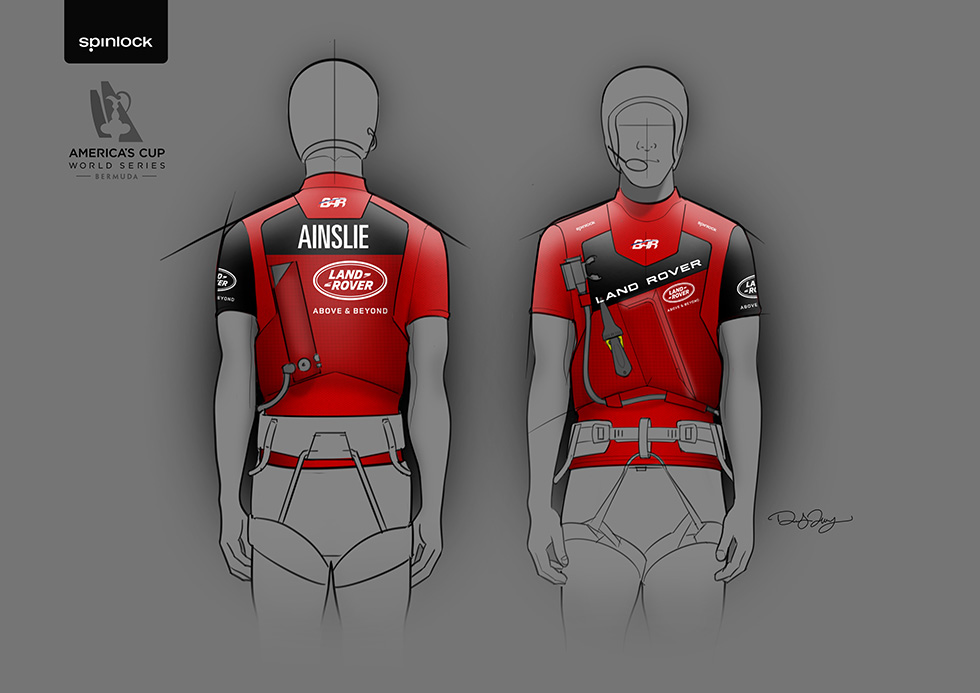
What have you worked on that you’re proud of and can share with our community?
Besides the products above, and because this is ‘Carryology’, some fun products I’ve been recently involved in in the realm of ‘carry’ have been the Black Diamond Distance Trail Running Packs, The Mission, Speed and Blitz Climbing Packs, The StoneHauler Duffle Bags, our new Haul Bags launching this spring, and some future-forward projects in the carry space I can’t speak to quite yet.
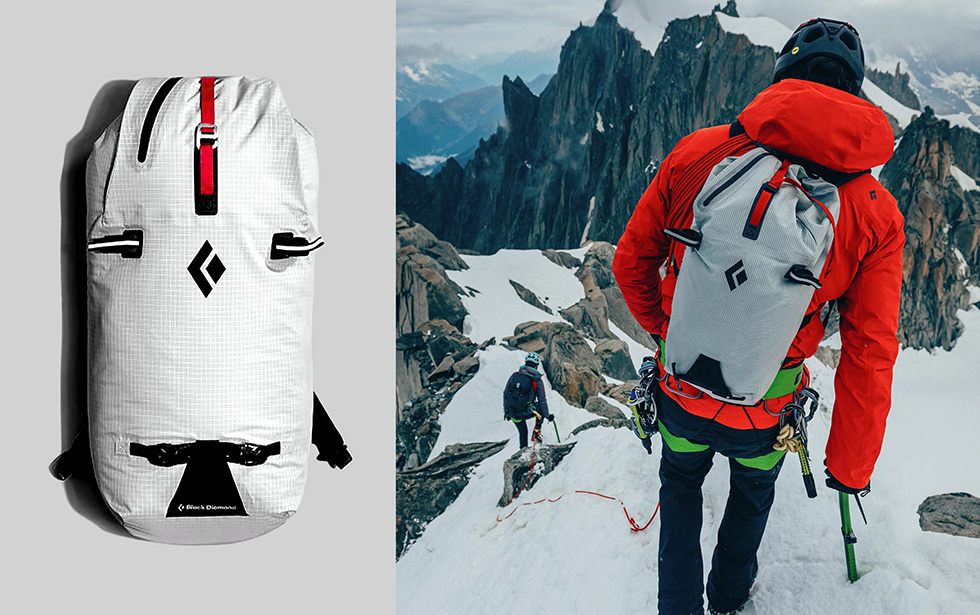
Outside of Black Diamond, roughly 5 years ago (seems like yesterday because of Covid) when I spent a year as a consultant to the brand I also worked for other friends in the industry such as Bellroy helping with some conceptual work on Apex wallets, Thule with some MTB hydration packs called Vital which won a Red Dot award for hydration innovation, Lander with some commuter packs called the Commuter and Traveler, as well as Mountain Hardwear and their climbing pack line.
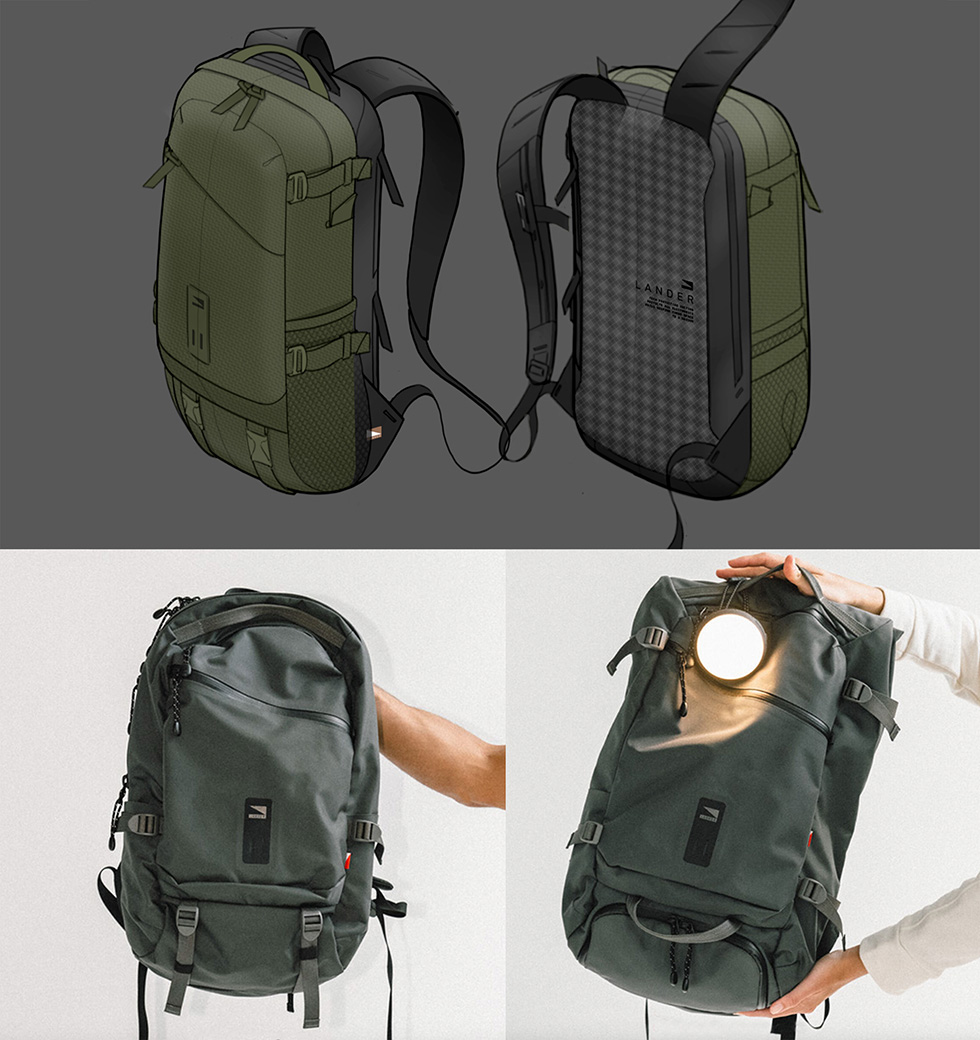
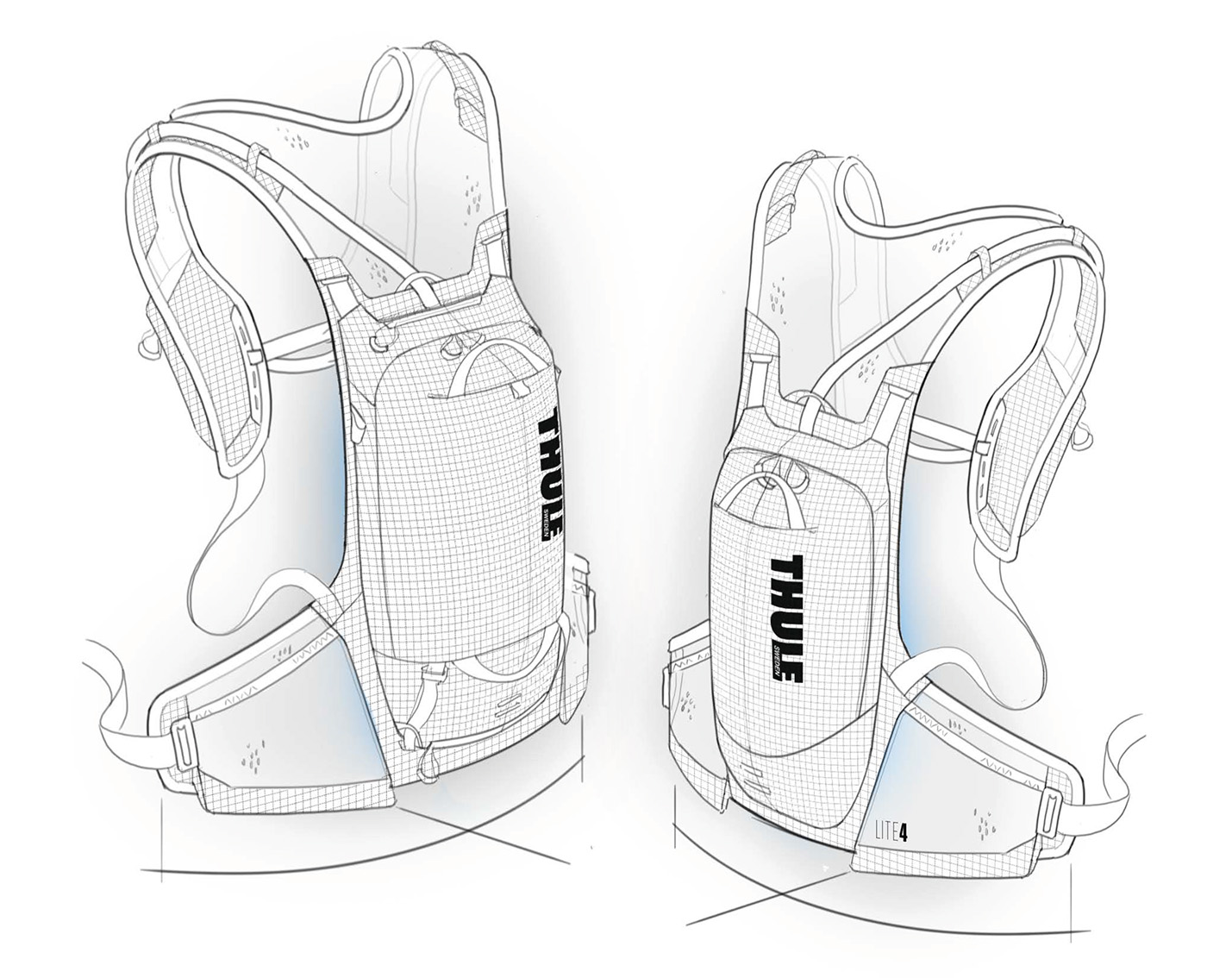
Jae Park
Jae Park has been in the design industry for over two decades, holding positions such as Director of Product Design at High Sierra and Design Director at Randa Accessories. Based in Chicago, he is experienced across the entire product development process from initial concepts and market research to final production. You can follow his work and learn more about his projects via Instagram and his website.
How did you get into design?
Originally, I went to school to major in architecture at the University of Illinois. Since I always loved doodling and sketching, I thought it was going to be a perfect fit for me. But I never got used to drawing straight lines, dotted lines, etc. Don’t get me wrong, there are beautiful architectural drawings that I can only dream about mimicking. At the time, the architecture department and the industrial design department were located in the same building. I decided to take an industrial design class out of curiosity, and I instantly fell in love with it.
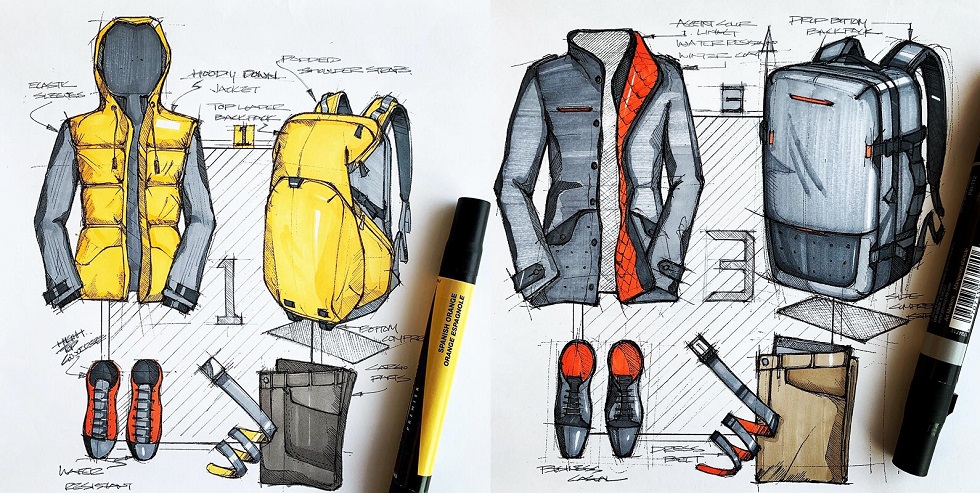
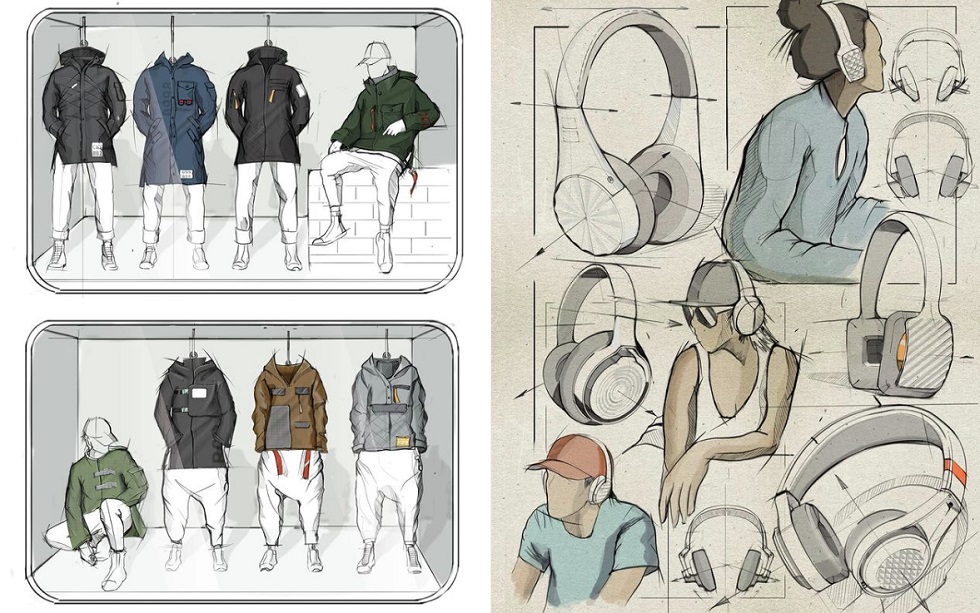
I just loved that I can be creative, being able to use a variety of colors and make product samples. After college, I became a toy designer in Chicago. Then a few jobs later, I took a position at a company that made back-to-school backpacks, outdoor hiking bags, and travel luggage. Since this company specialized in a variety of bag categories, I was able to grow as a well-rounded soft-goods designer.
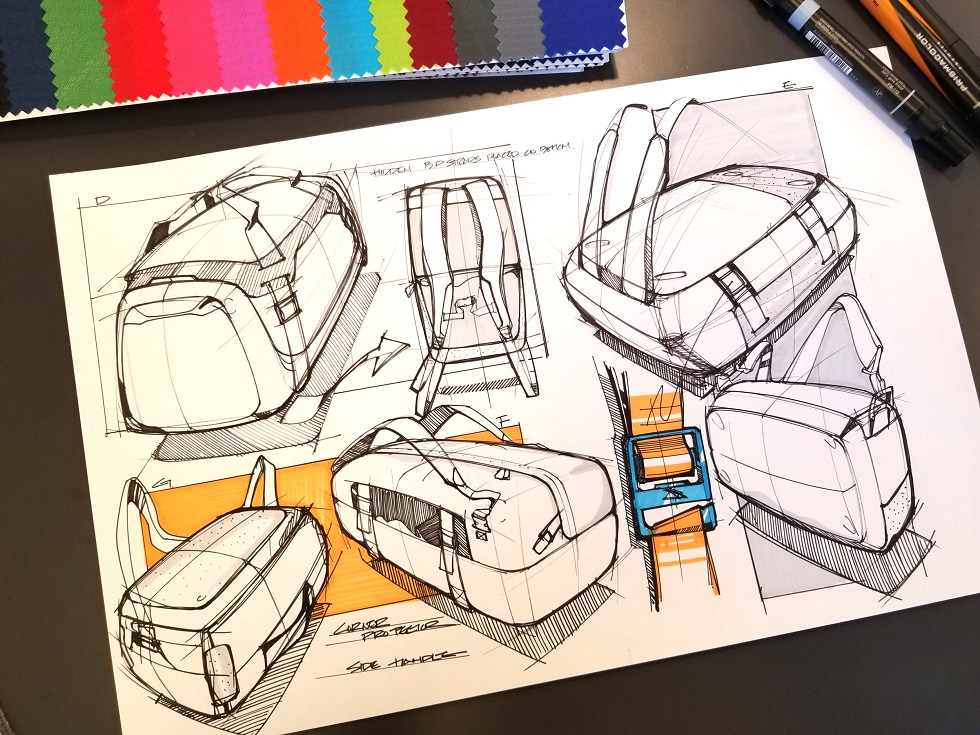
What inspires your work?
Earlier in my career, I was amazed that my sketches can become actual products.
However, these days I truly enjoy witnessing people using products that I’ve designed. Many times I see bags I designed coming out of belt conveyors at airports and people using the features I designed. For example, I have designed a 32″ wheeled duffel with tuck-away shoulder straps. This feature was designed for a dad who is traveling with two kids, so he can wear the duffel like a backpack and hold his two kids’ hands. A few months after launching that product, I saw a dad with the bag I designed holding two kids’ hands at the airport. A situation like this truly inspires me to design better products.
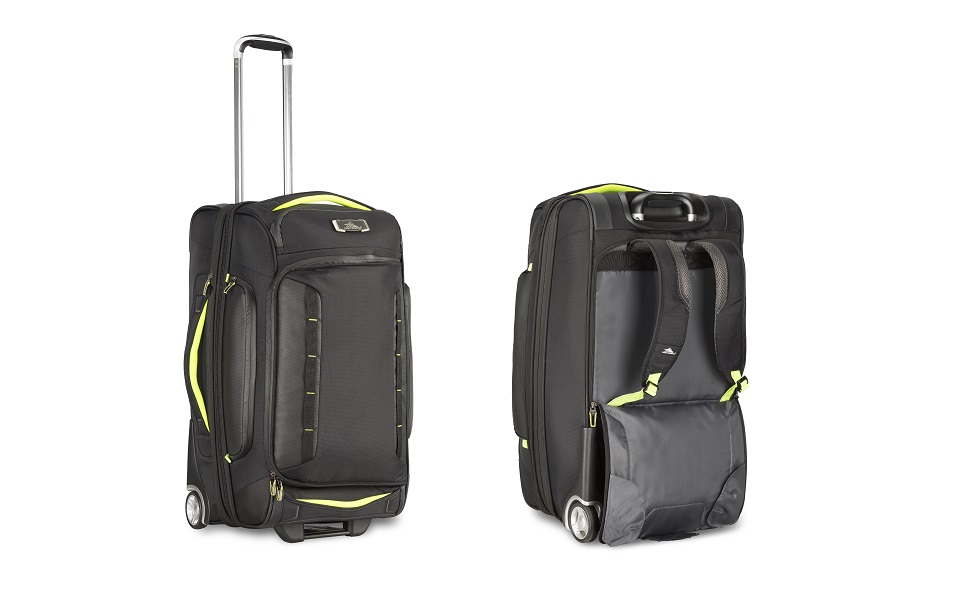
What products do you specialize in?
Because I have many years of experience designing backpacks for kids, business computer cases, outdoor frame packs, hydration packs, and travel luggage, I guess you can say I am trained to design any bags.
What have you worked on that you’re proud of and can share with our community?
A few years ago, I had an opportunity to design a collection of bags that can offer multiple travel bag options for department stores. It was a fairly challenging project since it had tough target retail costs, but I really liked how the products turned out.
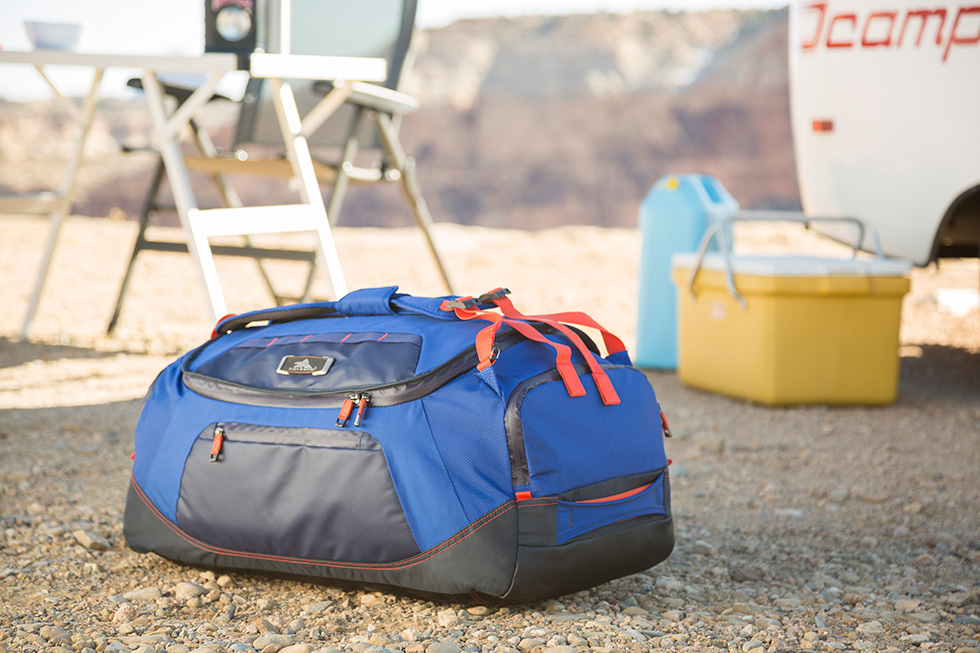
Aaron Puglisi
Aaron Puglisi is a soft goods designer for Bellroy and also a keen experimenter in the carry field with his creative side project, The Denier Lab. His design experience spans both footwear and soft goods, while his keen interest in exploring the possibilities of carry through The Denier Lab results in playful, unique, and eye-catching spins on traditional carry forms such as totes, pouches, and backpacks. Stay up to date with his creative journey on Instagram.
How did you get into design?
My childhood was pretty similar to a lot of other kids, in that it was filled with Legos and drawing, but I really got into making things as a teenager. Through most of my teens all I wanted to do was work on movies as a prop and set maker. There were a lot of weekends spent in the garage or basement recreating props from my favorite films. This was before you could find all the great tutorials on YouTube, so I just messed around and experimented on my own. One time I used some spray paint in the garage, and I accidentally got paint all over my mom’s car… I spent the rest of that weekend scrubbing off every last fleck of paint.
In college I was a ceramics major for almost two years before one of my teachers saw me doing some perspective drawings of products, and she suggested I look into industrial design. I had to look up industrial design online, but as soon as I read about it I knew it was the only job I wanted. Within just a couple weeks I had submitted a transfer request to a different university and applied to their industrial design program.
What inspires your work?
Films, fashion, military gear, techwear, footwear, and interior design. The list could go on. I think we are always pulling ideas from our experiences, both consciously and subconsciously. I’m on Pinterest and Tumblr every day, collating images and ideas into little projects.
Footwear is a really inspiring space. The social and financial power of sneakers means that they get a lot of attention and money put into them. The laminations and knits of modern footwear are both technically and aesthetically really impressive. I would like to see more of those elements applied to carry products in the future.
What products do you specialize in?
I work full-time as a soft goods designer, and ‘The Denier Lab’ projects fill in the nights and weekends. When I get time to work on TDL projects, I like to try quirky or strange things that might not be commercially viable. I think of those projects as experiments. They are pretty explorative: sometimes they work out, sometimes they don’t. All of my projects so far have been soft goods/bags, but I’d like to experiment with bag hardware as well.
What have you worked on that you’re proud of and can share with our community?
Working on these experimental projects is quite satisfying because even when a project doesn’t turn out perfect, I’m usually learning something. There are often little details in a project that I find really interesting and am most proud of.
For experiments 17, 18, 19, and 21 I repurposed some beautiful climbing harnesses from Black Diamond Equipment to make some odd little bags. Apart from the climbing harness elements, they all had seams that were bound to the exterior with webbing rather than a normal binding tape, and they also used a lot of hook and loop panels. Each of those bags played with asymmetry and different modes of carry.
Feature image credit: Patrick Christian
The post 8 Awesome Designers to Follow on Instagram appeared first on Carryology - Exploring better ways to carry.
